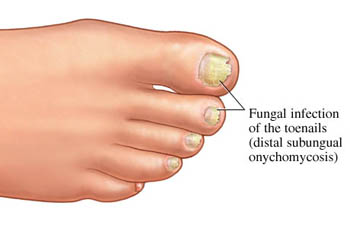Toenail Bruise: This injury usually occurs when another player steps on your foot, most commonly the big toe, resulting in mild to moderate pain and later a black toenail. The black/purplish discoloration is caused by traumatic injury to the blood vessels beneath the toenail. The pain generally will intensify in the acute phase (0-24 hours) due to the increase of pressure caused by leaking blood. If the discomfort is significant see a podiatrist who can help by drilling a small hole in the nail with a needle which allows the blood to leak out, relieving the pressure. This is best done within the first 24 hours of injury. Despite how it may sound, the procedure is painless. Your doctor can also check to make sure there aren't any other associated injuries like a broken bone or joint sprain. It is hard to predict whether or not the nail will fall off. Chances are highest if it has already become loose. You can tape the nail to try to hold it in place, but if it falls off you will probably want to protect the exposed sensitive tissue with padding when playing until a new nail grows in.
Ingrown Toenail: This occurs when a toenail grows downward into the toe pad rather than straight outward. The surrounding soft tissue becomes inflamed, red, swollen, and painful to touch or even when walking. On some occasions, the surrounding soft tissue can become infected with bacteria causing a discharge that is usually white or yellowish in color. It is seen with regular training and constant downward force generated by running and quick sprinting. Almost exclusively, the big toes are affected. Prevention can be accomplished with proper nail trimming technique. Trim toenails in a directly horizontal fashion leaving a small corner of nail extending just beyond the toe pad on either side. Should an ingrown toenail develop, there are a couple of ways it can be treated. If it is early and not infected, soak in warm Epsom salt water for 15-20 minutes 2-3 times daily. Shimming under the affected nail edge with cotton can help. Do not cut the nail corners as this only encourages the nail edge to grow further down and in. Should these measures fail or the surrounding soft tissue becomes infected see a podiatrist who may decide to prescribe antibiotics or remove part of the nail with a simple in-office procedure. This allows the soft tissue to heal and new nail to then grow in correctly over the next several months.
Turf Toe: This is a sprain of the first metatarsophalangeal joint (where the big toe meets the foot) occurring when the big toe is used like a springboard to propel the foot forward during sudden changes in running direction. It tends to be more common in those with flat feet, play on artificial turf (hence the name), or those participating in soft/flexible sole cleats. Indoor players may be particularly at risk. Symptoms usually include swelling and pain around the first MTP joint of the foot that gets worse with walking or movement of the affected toe. As with any injury it is always a good idea to see a doctor to confirm the diagnosis. Treatment consists of regular 15-20 minute icing sessions, anti-inflammatory pain medications, and decreased weight bearing activity for a few days to weeks. As you try to return to play, an athletic trainer may tape the joint or a rigid insert can be placed in the front of your shoe to limit extension of the big toe joint as you push off the ball of your foot. Outside of soccer, wear supportive, stiff-soled shoes to limit strain on the toe with regular walking. Recovery may take several weeks.
Toenail Fungus: This condition is caused by fungal organisms known as dermotophytes which are typically transmitted via contact with a colonized surface (shower floor, flip-flops, shoes, socks, etc). This is an infection of the nail itself, typically causing thickened, discolored (whitish-yellow), and brittle nails. Spreading to other nails on the same foot is a common problem. Toenail fungus is primarily a cosmetic problem and will generally not cause any other problems. Treatment of topical medications directly to the nail have had good success rates in our offices. Other options include laser treatment and oral medications.
Athlete's Foot: This is a burning/itching red rash on the feet located mostly between the toes but may spread onto the foot. It is caused by the same group of organisms that cause toenail fungus. These organisms flourish in warm, wet, dark places- which makes the feet/toes a perfect set-up- and can easily be passed between teammates. Again, shower floors, sharing shoes, locker room floors, etc. are the most likely sources. To prevent this problem: 1. Avoid barefoot exposure in locker rooms, gyms, showers, or sharing shoes, 2. You may also consider using baby powder on your feet with each practice/game to prevent excess moisture build-up, 3. Change your socks frequently and remove shoes as soon as possible after play (it helps to have a pair of sandals ready). Should you develop symptoms of Athlete's foot, you should visit a podiatrist to discuss treatment options.
If you are a soccer player with a foot injury, call our Newington, Kensington, or Middletown office to make an appointment.
Craig M. Kaufman, DPM
Connecticut Foot Care Centers
Sports Podiatrist in CT
Podiatrist in Newington, Kensington, and Middletown, CT
Visit our website, friend and like our page on Facebook, and follow my tweets on Twitter.
Athletes are notoriously hard on all parts of their body, but in particular their feet and ankles. From football to basketball to running, when you participate in any sporting event you need to be looking out for your feet. Let Jeffrey S. Kahn, DPM and his staff at Connecticut Foot Care Centers in Rocky Hill and Middletown take care of you!
Tuesday, August 28, 2012
Foot Injuries in Soccer
Subscribe to:
Post Comments (Atom)





No comments:
Post a Comment